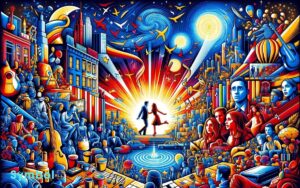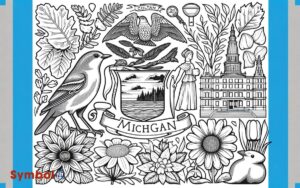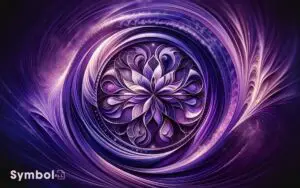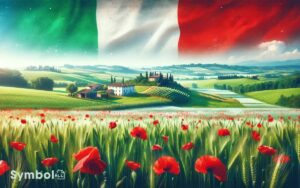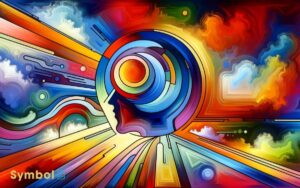What Does the Color Red Symbolize in the Great Gatsby?
In “The Great Gatsby,” you’ll find that red symbolizes a whirlwind of passion, danger, and decadence. It critiques the recklessness and moral decay pervading society, highlighting characters’ deep desires for power and control.
Red signals not just love, but also the peril that follows closely behind, warning of death and destruction.
This color captures the intensity of forbidden desires and the prestige sought after by those chasing the American Dream, foreshadowing the tragic unravelling. It embodies rebellion, shedding light on societal upheavals and the personal revolutions within.
Each brush stroke of red reveals more layers to uncover, hinting at the depth of exploration that lies ahead.
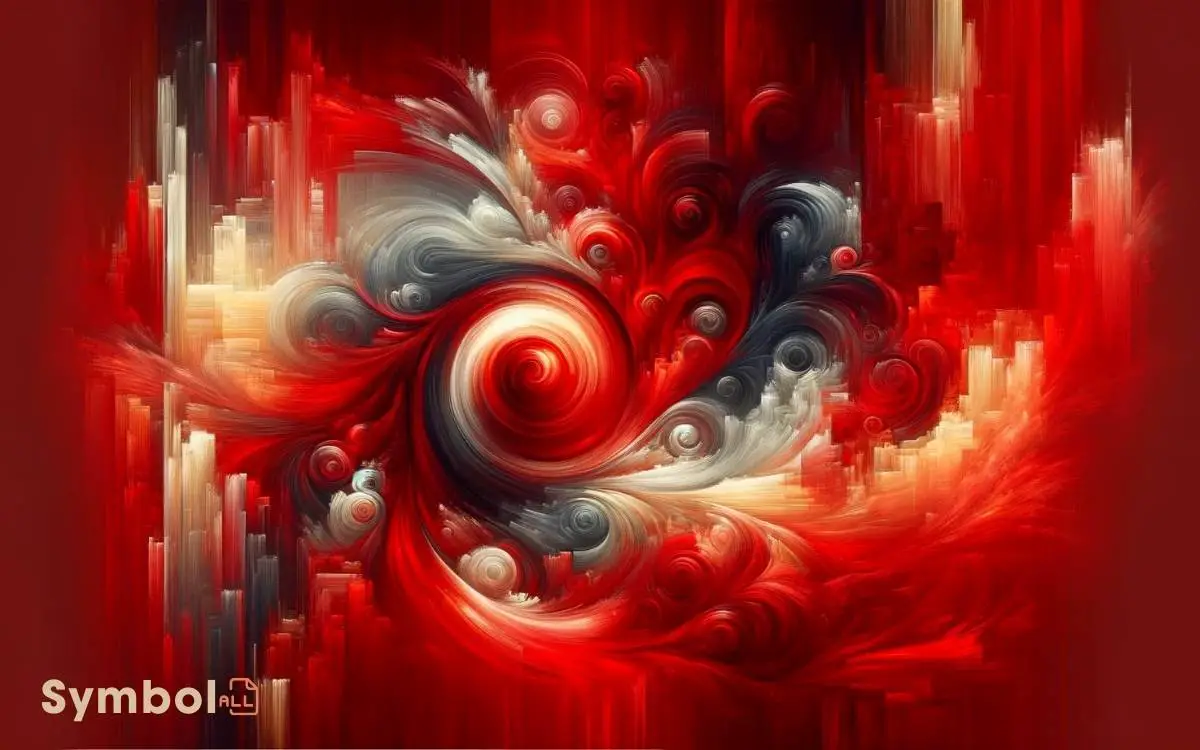
Key Takeaway
The Symbolism of Red
In F. Scott Fitzgerald’s ‘The Great Gatsby,’ the color red serves as a powerful symbol, embodying themes of passion, danger, and power, intricately woven into the narrative to reveal deeper insights into the characters’ lives and the society they inhabit.
You’ll notice red’s symbolism extends to danger and power through its presence at critical moments.
When Tom Buchanan’s car, described as red, is involved in Myrtle’s death, red not only signals the immediate danger but also reflects the destructive power wielded by the wealthy characters.
This event underlines how their actions, driven by their desires and societal status, have far-reaching, fatal consequences.
Fitzgerald uses red to critique the recklessness and moral decay hidden beneath the surface of opulence, showcasing how the characters’ pursuit of power and control leads to inevitable downfall and tragedy.
Passion and Desire
Beyond signaling danger and power, red also vividly captures the intensity of passion and desire that fuels the characters’ actions and decisions throughout ‘The Great Gatsby.’
This hue isn’t just a backdrop; it’s a crucial heartbeat within the novel, pulsating with the unfulfilled longings and fervent aspirations of its characters.
Take, for example, the red-lit parties at Gatsby’s mansion, symbolizing both his burning love for Daisy and his fervid pursuit of the American Dream. It’s in these crimson shades that you see Gatsby’s heart laid bare, his yearning not just for Daisy’s affection but for an idealized past they once shared.
This passionate hue envelops the narrative, reminding you that at its core, Gatsby’s story is one of profound desire, a longing not just for love, but for an unreachable, glittering dream.
Power and Prestige
The color red also serves as a powerful emblem of power and prestige in ‘The Great Gatsby,’ reflecting the societal status aspirations and the commanding presence of its characters.
You’ll notice how Fitzgerald meticulously uses red to highlight the luxurious lifestyle and opulence that characters like Tom Buchanan and Jay Gatsby embody.
The red decorations at Gatsby’s lavish parties aren’t just about wealth; they’re a visual manifestation of his intense desire to be revered and to belong to the upper echelon of society.
Similarly, Tom’s red coupe symbolizes not just his wealth but his dominance and authority in a society obsessed with material success.
Through these elements, Fitzgerald ingenially showcases how the pursuit of power and prestige drives the actions and motivations of his characters, painting a vivid picture of the Jazz Age’s glittering facade.
Danger and Warning
Fitzgerald skillfully employs the color red as a harbinger of danger and warning, subtly foreshadowing the tragic events that ultimately unravel in the narrative of ‘The Great Gatsby’.
This choice isn’t arbitrary; rather, it’s deeply intentional, inviting you to look beyond the surface glamour to the underlying turmoil. Red signals caution, urging you to notice the precarious situations that characters navigate.
It’s in the crimson shades of the sunset before Gatsby’s parties, hinting at the volatile nature of their opulence.
Similarly, the red light at the end of Daisy’s dock isn’t just a beacon; it’s a warning sign, symbolizing Gatsby’s dangerous obsession with recapturing a past that’s slipping away.
Through these elements, Fitzgerald masterfully uses red to indicate looming peril, engaging you in a deeper analysis of the story’s unfolding drama.
Death and Destruction
Delving into the narrative of ‘The Great Gatsby’, red emerges not just as a harbinger of danger, but also as a profound symbol of death and destruction that pervades the storyline. You notice how Fitzgerald weaves red into moments that foreshadow or depict loss and ruin.
| Instance | Significance |
|---|---|
| Myrtle’s death | Red, the color of the car, symbolizes the violent end and the repercussions it has on multiple characters. |
| George’s despair | His red bloodshot eyes represent his devastation and foreshadow his destructive decisions. |
| Gatsby’s pool | The water tinged with red hints at Gatsby’s impending death, underscoring the ultimate destruction of his dreams. |
| The Valley of Ashes | Red fires and lights illustrate the decay of the American Dream and the mortality of its pursuers. |
| Daisy’s red lips | While closely tied to passion, they also hint at the dangerous consequences of her actions. |
Fitzgerald’s deliberate use of red to signify death and destruction invites you to ponder the deeper implications behind the apparent glamour and opulence of the era.
Love and Jealousy
As you explore the symbolism of red in ‘The Great Gatsby’, you’ll find it intricately linked to the raw, passionate desires that drive the narrative forward.
This intensity is mirrored in the emergence of jealousy, the green-eyed monster, showcasing how love and envy are two sides of the same coin in Fitzgerald’s world.
Through the lens of red, the novel exposes the dangerous dance between love’s fervor and jealousy’s destruction.
Passionate Desires Unleashed
In The Great Gatsby, the color red vividly captures the raw intensity of characters’ passionate desires and the deep-seated jealousy that entangles their relationships.
This fiery hue symbolizes not just love in its purest form but also the dangerous obsession that can arise from unfulfilled yearnings.
When you explore further, red’s presence is a constant reminder of the thin line between passion and destruction. It’s in the lavish parties, the luxurious cars, and the characters’ wardrobe, acting as a visual cue for the reader to sense the underlying turmoil.
The color’s boldness mirrors the characters’ willingness to break societal norms in pursuit of their desires. Yet, it also foreshadows the inevitable consequences of their reckless pursuits, painting a complex picture of love’s power and peril.
Green-Eyed Monster Emerges
Building on the vivid symbolism of red in passionate desires, the emergence of the green-eyed monster in ‘The Great Gatsby’ highlights the intricate dance between love and jealousy among the characters.
This complex emotion surfaces as characters grapple with their desires and the reality of their situations.
Jay Gatsby, for instance, is consumed by his love for Daisy, which morphs into jealousy over her relationship with Tom. This jealousy clouds his judgment, propelling him towards destructive decisions.
Similarly, Tom Buchanan’s possessiveness over Daisy manifests as jealousy towards Gatsby, leading to conflicts that underscore the novel’s tragic elements.
Fitzgerald masterfully uses these dynamics to explore how love can be tainted by jealousy, affecting one’s perception and actions, ultimately revealing the darker facets of human emotions.
Wealth and Opulence
The color red frequently mirrors the exuberance and extravagance of wealth and opulence, casting a vivid light on the characters’ lifestyles within ‘The Great Gatsby.’
This hue embodies the lavish parties thrown by Gatsby, where the opulence isn’t just a backdrop; it’s a character in its own right, pulsating with life.
The reds in Gatsby’s world aren’t just colors; they’re symbols of the power and prestige that wealth can buy.
They whisper of secret desires and hidden depths, where the exploration of the American Dream becomes intertwined with the pursuit of pleasure.
As you investigate further, you’ll notice how red serves as a beacon, drawing characters into a world where wealth isn’t just seen, it’s felt, radiating through every extravagant party and luxurious detail, defining their very existence.
Anger and Aggression
Shifting focus from the opulence, red also captures the intensity of anger and aggression that simmers beneath the surface of The Great Gatsby’s characters, revealing how wealth can fuel not just ambition, but also destructive passions.
It’s not merely a backdrop but a vivid signal of the emotional chaos and conflicts that drive the narrative.
When you examine the text closely, red is often a harbinger of violence and fury, underscoring key moments that pivot on heated emotions.
This color, so deeply intertwined with the characters’ psyches, serves as a visual cue for you to anticipate the eruption of pent-up frustrations and rivalries.
It’s a nuanced symbol, offering insight into how affluence can exacerbate personal grievances and societal tensions, making it impossible to ignore the darker, more aggressive undercurrents at play.
Vitality and Life
Examining the vibrant shade of red in The Great Gatsby also reveals its role as a symbol of liveliness and the pulsating life force driving its characters’ desires and actions. The color red often underscores moments of passion, urgency, and fervent emotion, capturing the intensity of the characters’ pursuits and the often-destructive nature of their aspirations. Whether it’s the rich crimson of a party dress or the glow of taillights speeding down a darkened road, red embodies both vitality and recklessness. This vivid use of color symbolism in The Great Gatsby weaves a deeper layer of meaning throughout the narrative, highlighting the duality of life’s vibrancy and the dangerous obsessions that can accompany it.
This color’s presence isn’t just an aesthetic choice; it’s a deliberate nod to the dynamic energy and the pursuit of dreams that define the novel’s essence.
Consider these points:
- Gatsby’s Parties: Red is the backdrop of opulence and vitality, where the characters’ zest for life is most palpable.
- Daisy’s Lips and Car: Symbolizing her vibrant, yet capricious nature, drawing Gatsby and others into her orbit.
- The Valley of Ashes: The occasional red flashes serve as stark contrasts, highlighting moments of life amidst desolation.
Through these elements, red encapsulates the dynamic forces that drive the narrative forward.
Illusion and Reality
In ‘The Great Gatsby,’ the color red not only signifies liveliness but also blurs the lines between illusion and reality.
You’ll see how Gatsby’s opulent facade, highlighted by lavish red decorations, masks his inner longing and despair, juxtaposing his apparent success with his unfulfilled desires.
Similarly, Daisy’s dual nature, adorned in red, reveals her vibrant exterior while concealing her profound ambivalence, further complicating the tension between dreams and reality.
Gatsbys Lavish Facade
Jay Gatsby’s meticulously crafted persona, symbolized through his extravagant parties and opulent lifestyle, serves as a vivid illusion masking the reality of his unfulfilled desires and complex identity.
This facade isn’t merely for show but a calculated attempt to reclaim a lost love and rewrite his past.
Gatsby’s illusion of grandeur is underscored by:
- His Grandiose Parties: Each event is a spectacle, designed to attract Daisy’s attention and proclaim his newfound wealth.
- The Lavish Mansion: His home isn’t just a residence but a symbol of his achievements and his attempt to belong to the upper class.
- The Opulent Clothing: Gatsby’s wardrobe, especially the use of the color red, signifies his passion and determination but also highlights the depth of his pretenses.
Each element meticulously contributes to the facade Gatsby has constructed, revealing the poignant disparity between illusion and reality in his life.
Daisys Dual Nature
Just as Gatsby’s grandeur masks his inner turmoil, Daisy Buchanan’s charm and beauty conceal a complex blend of illusion and reality, revealing her dual nature. This duality isn’t merely superficial but is deeply ingrained in her character.
Daisy portrays herself as innocent and ethereal, yet her actions and choices reflect a more sordid, self-serving reality.
Her allure lies in this very complexity, as she embodies the quintessential illusion that Gatsby, and by extension, the reader, desperately wants to believe in.
However, beneath this facade lies a reality marked by indifference and a lack of genuine affection.
Daisy’s character serves as a poignant reminder that behind every enchanting illusion, there often lurks a starkly different reality, challenging us to see beyond the surface.
Dreams Versus Reality
While F. Scott Fitzgerald masterfully blurs the lines between dreams and reality in ‘The Great Gatsby,’ he also exposes the harsh truth that the American Dream often serves as a mere illusion, masking the grim realities of society’s moral decay.
To paint a picture for you:
- Gatsby’s Lavish Parties: These symbolize the extravagant dreams of wealth and happiness. Yet, they’re superficial gatherings that lack genuine fulfillment or joy, showcasing the emptiness beneath the opulence.
- Daisy Buchanan: She epitomizes Gatsby’s ultimate dream. However, her shallow nature and indecisiveness reflect the disillusionment with the pursuit of such a dream.
- The Valley of Ashes: This represents the reality for the majority, a stark contrast to Gatsby’s glittering world, highlighting the disparity between the wealthy and the impoverished, and the destruction left in the wake of blind ambition.
Rebellion and Revolution
In F. Scott Fitzgerald’s ‘The Great Gatsby,’ the color red serves as a potent symbol of rebellion and revolution, challenging the established norms and sparking a deeper analysis of the era’s societal upheavals.
This vibrant hue embodies the boldness and defiance of characters aspiring to break free from the constraints of their rigid social hierarchies.
It’s not just a mere backdrop; it’s a visual manifestation of the tumultuous desire for change. Every appearance of red—from the crimson rooms to the characters’ attire—echoes the restless spirit of the age, encapsulating a yearning for a new social order.
Through this lens, Fitzgerald critiques the status quo, urging you to see beyond the surface and recognize the undercurrents of discontent and desire for transformation that define the novel’s heart.
Mystery and Secrecy
As you explore the symbolism of red in ‘The Great Gatsby,’ you’ll uncover how it intricately weaves into the tapestry of mystery and secrecy.
The lavish parties at Gatsby’s mansion, shrouded in opulence, hide a deeper quest for acceptance and love, masked by the red-hued extravagance.
Myrtle’s hidden desires and East Egg’s elusive aura, both tinged with shades of red, invite a closer look at how color underscores the characters’ concealed truths and the societal facades they maintain.
Secrets Behind Gatsbys Parties
Gatsby’s extravagant parties, veiled in opulence, serve as a facade for the deeper secrets and mysteries he harbors, inviting a closer examination of their true purpose.
These celebrations aren’t merely social gatherings; they’re a meticulously constructed spectacle designed to mask Gatsby’s true intentions and past.
To understand the layers, consider:
- The Quest for Daisy’s Attention: The grandeur aims to lure Daisy, symbolizing Gatsby’s desperate pursuit of his lost love.
- A Facade of Wealth and Power: These events project an image of success, distracting from Gatsby’s murky origins and illicit wealth.
- The Isolation Amidst Company: Despite the crowds, Gatsby remains a solitary figure, hinting at his deep loneliness and the superficial nature of his connections.
Through these parties, Fitzgerald peels back the layers of Gatsby’s persona, revealing the complexities and contradictions of his character and the society he inhabits.
Myrtles Hidden Desires
Myrtle Wilson’s pursuit of a life draped in luxury and societal recognition reveals her deep-seated yearning for escape from her mundane existence. She’s trapped, not just by her marriage to George Wilson, but by the era’s societal constraints.
Her affair with Tom Buchanan is less about love and more about her aspirations for a grander life, symbolizing her hidden desires and the secrecy that shrouds her true ambitions.
| Aspect | Significance |
|---|---|
| Luxury | Represents the escape Myrtle yearns for. |
| Affair | Symbolizes her rejection of societal norms. |
| Societal Role | Highlights the constraints she’s battling. |
East Eggs Elusive Aura
Exploring the world of East Egg reveals an aura of mystery and secrecy, reflecting the complex social dynamics and hidden truths of its inhabitants.
This setting, rich in symbolism and nuance, offers you a glimpse into the intricate layers that define the characters and their relationships.
To understand its elusive aura, consider the following:
- The Facade of Opulence: Beneath the surface of lavish parties and grand estates lies a deep-seated emptiness and moral decay.
- Social Stratification: The rigid class distinctions create barriers, fostering an environment of exclusivity and isolation.
- Unspoken Histories: Characters in East Egg harbor secrets that shape their actions and relationships, adding layers of complexity to their interactions.
Analyzing these elements provides insight into the subtleties of East Egg’s society, where appearances often mask a darker reality.
Transformation and Change
In F. Scott Fitzgerald’s ‘The Great Gatsby,’ the color red serves as a powerful emblem for exploration and change, mirroring the tumultuous shifts within the characters’ lives and society at large.
As you investigate further, you’ll notice red not just as a backdrop but as a pivotal element highlighting moments of significant change.
It’s present at Gatsby’s opulent parties, symbolizing his dramatic transformation from a poor young man to a wealthy socialite, attempting to reshape his identity and destiny. Red also underscores the violent end of Myrtle, marking a critical turning point in the narrative.
This vivid hue encapsulates the essence of change, from personal reinvention to societal upheavals, inviting you to reflect on the inevitable nature of transformation and its profound impacts.
Conclusion
So, after gallivanting through the crimson-hued labyrinth of ‘The Great Gatsby,’ what’ve we learned?
That red isn’t just the color of love but a siren screaming of danger, a lavish curtain of prestige, and the blood-stained banner of rebellion.
It’s as if Fitzgerald dipped his pen in the wine of Dionysus and painted a world where every red splash whispers of passion, warns of doom, and dances between the illusory and the real.
In Gatsby’s universe, red isn’t merely a color; it’s the heartbeat of a feverish dream, pulsating with the rhythm of desire, power, and the inevitable fall from grace.
So next time you see red, remember, it’s not just a color—it’s a story, a warning, a promise of transformation, all rolled into one.

